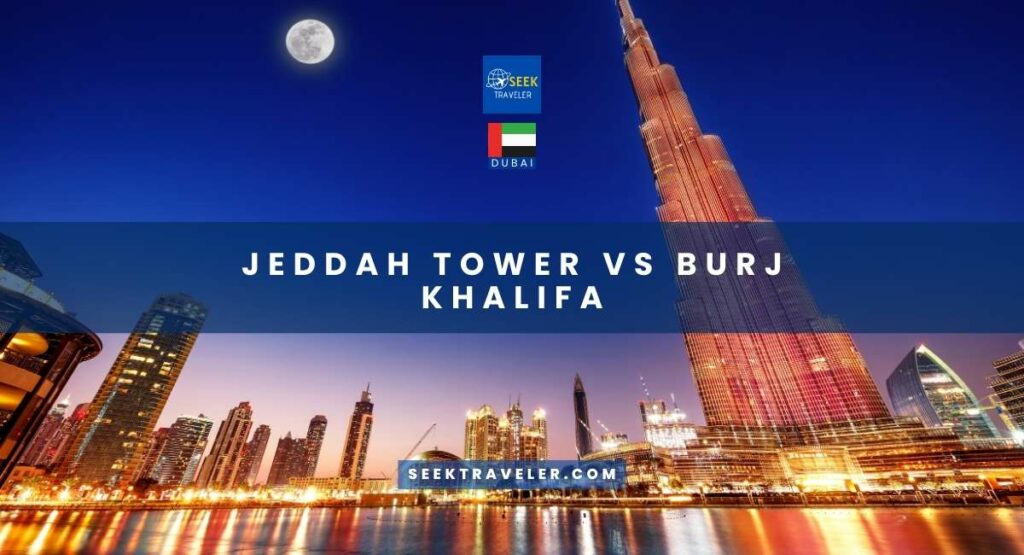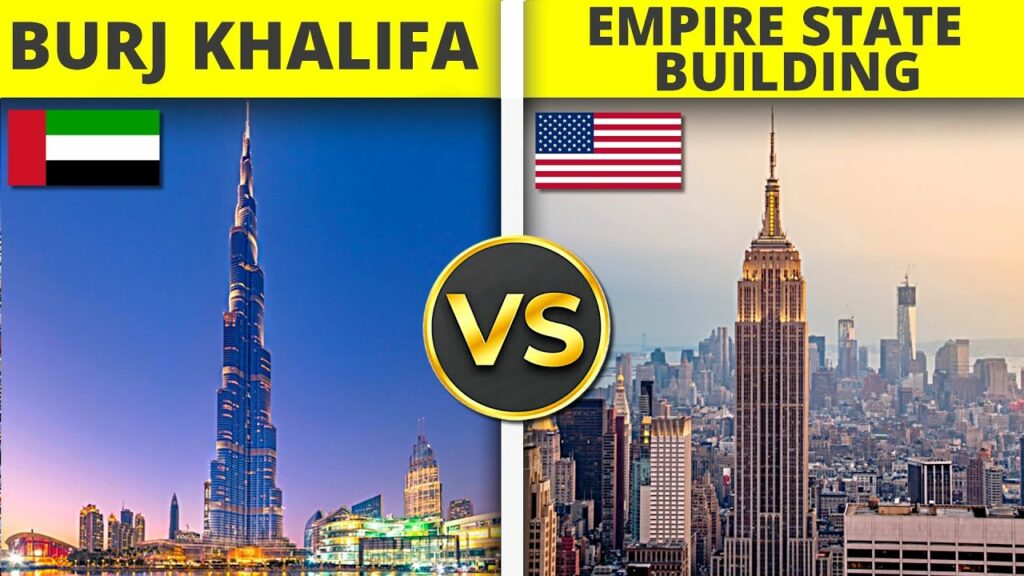As someone who has always been fascinated by skyscrapers, I couldn’t help but be drawn to the comparison between Jeddah Tower and Burj Khalifa. Both buildings are engineering marvels that push the boundaries of what’s possible in terms of height and design.
As someone who appreciates both technical precision and architectural beauty, I’m eager to explore the similarities and differences between these two iconic structures.
At first glance, it might seem like these two buildings are quite similar: they’re both located in the Middle East, they both boast impressive heights, and they were both designed by world-renowned architects. However, as I delved deeper into their stories, I realized that there are many nuances to consider when comparing Jeddah Tower and Burj Khalifa.
From their purpose and function to the challenges faced during construction, each building offers unique insights into what it takes to create a modern-day skyscraper.
Height and Design
Get ready to be amazed by the stunning height and unique design of these two architectural wonders.
The Burj Khalifa, located in Dubai, United Arab Emirates, stands at an impressive height of 828 meters (2,716 feet) and is currently the tallest building in the world. Its sleek and modern design features a Y-shaped floor plan that maximizes natural light and offers breathtaking views of the surrounding cityscape.
On the other hand, Jeddah Tower, also known as Kingdom Tower, will soon surpass Burj Khalifa’s current record with a projected height of 1 kilometer (3,281 feet) upon completion. The tower’s spiraling design mimics that of a desert plant shooting upwards towards the sky and will certainly make for an awe-inspiring sight once construction is finished.
Moving on to structural engineering…
Structural Engineering
You’ll be amazed by the complexity and precision that went into designing and constructing both the Jeddah Tower and the Burj Khalifa. These skyscrapers are not just tall buildings, but engineering marvels that required innovative structural techniques to ensure their stability and safety.
The Jeddah Tower features a unique ‘buttressed core’ design that provides additional support against wind loads while reducing building sway. This design was made possible through advanced computer modeling and analysis, which allowed engineers to simulate various scenarios and optimize the tower’s shape and structure.
Similarly, the Burj Khalifa also boasts cutting-edge structural engineering innovations, such as its ‘Y-shaped’ plan, which maximizes views of the surrounding landscape while minimizing wind forces on the building. To accommodate its immense height, it also features a sophisticated system of elevators that travel at speeds of up to 40 miles per hour. All these technical advances were necessary to create safe and functional spaces within these towering structures.
Now let’s explore how each building serves its purpose in even greater detail.
Purpose and Function
When it comes to the purpose and function of Burj Khalifa and Jeddah Tower, there are some notable differences worth discussing. As someone who’s keen on architecture, I find it fascinating to compare the two structures in terms of their intended usage and occupancy.
While both buildings are impressive feats of engineering, they were designed with different goals in mind.
Burj Khalifa’s Purpose and Function
You might be surprised to know that the Burj Khalifa serves more than just a simple purpose as a building. It functions as an iconic symbol of Dubai’s modernity and success.
Standing at 828 meters tall, the Burj Khalifa is not only the tallest building in the world but also houses offices, residential spaces, restaurants, and observation decks.
The tower was built with multiple purposes in mind. While it serves as a commercial space for businesses and residents alike, its observation deck on the 148th floor provides breathtaking views of Dubai’s skyline. The building also houses an Armani Hotel and residences on its lower floors.
With such diverse functionality, the Burj Khalifa has become one of Dubai’s most recognizable landmarks and a symbol of its rapid growth and development.
Speaking of which, let’s now explore Jeddah Tower’s purpose and function.
Jeddah Tower’s Purpose and Function
Exploring the purpose and function of Jeddah Tower provides insight into another iconic symbol of modernity and development. The tower, currently under construction in Jeddah, Saudi Arabia, is expected to surpass the Burj Khalifa once completed.
Designed by Adrian Smith + Gordon Gill Architecture, it serves as a mixed-use building with commercial, residential, and hotel spaces. The tower’s height will reach over 1 kilometer (3,280 feet) with over 200 floors.
Its purpose is to bring attention to Jeddah as an emerging global city while also providing space for luxury living and business operations. It is set to become a major landmark in the region and a source of pride for Saudi Arabia.
Understanding its design and purpose helps contextualize how it differs from the Burj Khalifa in usage and occupancy.
Differences in Usage and Occupancy
You’ll notice the key distinctions between how Jeddah Tower and Burj Khalifa are used and occupied. While both buildings are designed for mixed-use purposes, each has its own unique characteristics.
Burj Khalifa, for example, is primarily an office building with some residential units on the upper floors. Jeddah Tower, on the other hand, is primarily a residential building with some hotel rooms and office space on the lower floors.
The occupancy rates of these two buildings also differ significantly. Burj Khalifa has a much higher occupancy rate due to its location in Dubai’s central business district and its popularity among multinational corporations. In contrast, Jeddah Tower is located in Jeddah’s north end near the Red Sea coast but still under construction as it faces various challenges such as financing and design issues. Nonetheless, it is expected to attract wealthy residents from around the world once completed.
As we move into discussing construction challenges faced by these two towers, it’s worth noting that their different usage patterns have influenced many aspects of their design and engineering decisions.
Construction Challenges
I found the construction challenges of both Burj Khalifa and Jeddah Tower to be fascinating. Both buildings faced unique obstacles during their construction, from extreme weather conditions to logistical issues.
Despite these challenges, they were able to overcome them and create two iconic structures that are recognized around the world. It’s interesting to compare and contrast their different constraints and how they were addressed by each project team.
Burj Khalifa’s Construction Challenges
The construction of the world’s tallest building wasn’t a walk in the park, as Burj Khalifa faced numerous hurdles and obstacles that put its completion at risk.
The tower was built on soft soil, which meant that engineers had to come up with innovative foundation designs to ensure the building could withstand high winds and earthquakes.
Additionally, constructing such a tall structure required advanced technology and materials that weren’t readily available in Dubai.
Another challenge was managing the logistics of getting workers and materials to the top of the building. The project required over 12,000 workers at its peak and involved transporting heavy equipment and materials up to heights of over 800 meters.
Despite these difficulties, however, Burj Khalifa was completed in just five years.
Now let’s take a look at some of the challenges faced during the construction of Jeddah Tower.
Jeddah Tower’s Construction Challenges
You’re in for a wild ride as the challenges faced during the construction of Jeddah Tower will make your heart race. The tower, which is set to surpass Burj Khalifa as the tallest building in the world, has encountered numerous obstacles since its inception.
One major challenge has been the unique geology of the site, which is situated on soft marine clay and sand. This required extensive soil testing and analysis to determine how deep foundations needed to be dug.
Another significant obstacle has been securing funding for such a massive project. The initial cost estimate was $1.5 billion, but as with any large-scale construction venture, costs have skyrocketed beyond this amount.
Additionally, there have been concerns about safety measures surrounding such a tall structure and ensuring that it can withstand strong winds and earthquakes.
Despite these hurdles, progress continues on Jeddah Tower’s construction, with an anticipated completion date of 2022.
As we move into discussing differences in construction constraints between Jeddah Tower and Burj Khalifa, it’s important to note that each building presents its own unique set of challenges.
Differences in Construction Constraints
Building the tallest structure in the world requires overcoming unique challenges that differ between various constructions. While both Jeddah Tower and Burj Khalifa are incredibly tall skyscrapers, they faced different constraints during their construction.
One major difference between the two projects is their location. The Burj Khalifa was built in Dubai, where there are relatively few earthquakes to worry about. On the other hand, Jeddah Tower is being constructed in an area with a higher risk of seismic activity, which has required additional engineering considerations to ensure its stability.
Another major difference is that Jeddah Tower is being built on a much smaller plot of land than the Burj Khalifa. This has meant that engineers have had to be creative with how they use space and materials during construction. For example, instead of using traditional cranes for lifting materials up to higher floors, they’re using self-climbing cranes that can move up along with the building as it grows taller.
These differences in construction constraints highlight the unique challenges facing each project and demonstrate the ingenuity required to overcome them.
As we look towards future prospects for these structures, it’ll be interesting to see how technology continues to advance and shape our ability to build ever taller buildings.
Future Prospects
Looking ahead, it seems like the sky’s the limit for what these architectural giants will accomplish in the years to come. The Jeddah Tower and Burj Khalifa have set a new standard for skyscrapers, with their incredible height and innovative designs. As technology advances and construction techniques improve, we can expect even taller and more impressive buildings to emerge.
The Jeddah Tower, in particular, has ambitious plans for its future. Once completed, it will be not only the tallest building in the world but also a center of commerce and entertainment. Its design incorporates sustainable features such as wind turbines and solar panels to reduce energy consumption. Additionally, there are plans for an observation deck on one of the highest floors that will offer breathtaking views of the city.
It is clear that both towers will continue to push boundaries and inspire awe for generations to come.
Conclusion
Well folks, after diving into the fascinating world of skyscrapers, it’s clear that both the Jeddah Tower and Burj Khalifa have their own unique strengths and challenges.
Height-wise, the Jeddah Tower is set to be taller than its predecessor by a staggering 236 meters. And while the Burj Khalifa boasts an iconic design that has captured hearts around the world, the Jeddah Tower’s sleek and modern architecture is sure to turn heads.
In terms of structural engineering, both buildings are marvels in their own right. But with advancements in technology since the construction of the Burj Khalifa, engineers have been able to create a building that can withstand even stronger winds and earthquakes.
As for purpose and function, each building serves as a symbol of progress for their respective countries – not just as architectural feats.
Overall, comparing these two giants was like comparing apples to oranges – they’re both impressive in their own way. But if I had to choose one idiom to sum up my thoughts on this topic: “You can’t judge a book by its cover.” Because when you look deeper into these structures – beyond their height or design – you’ll find incredible stories of innovation, perseverance, and human achievement.

Meet Scott Robinson, a seasoned traveler with 28 countries under his belt, has immersed himself in diverse cultures around the world. His articles are a window into the rich tapestry of traditions, customs, and local flavors he has encountered on his globetrotting escapades. Scott’s deep appreciation for the beauty of cultural diversity shines through his writing, allowing you to embark on a virtual journey that celebrates the vibrant mosaic of humanity.



